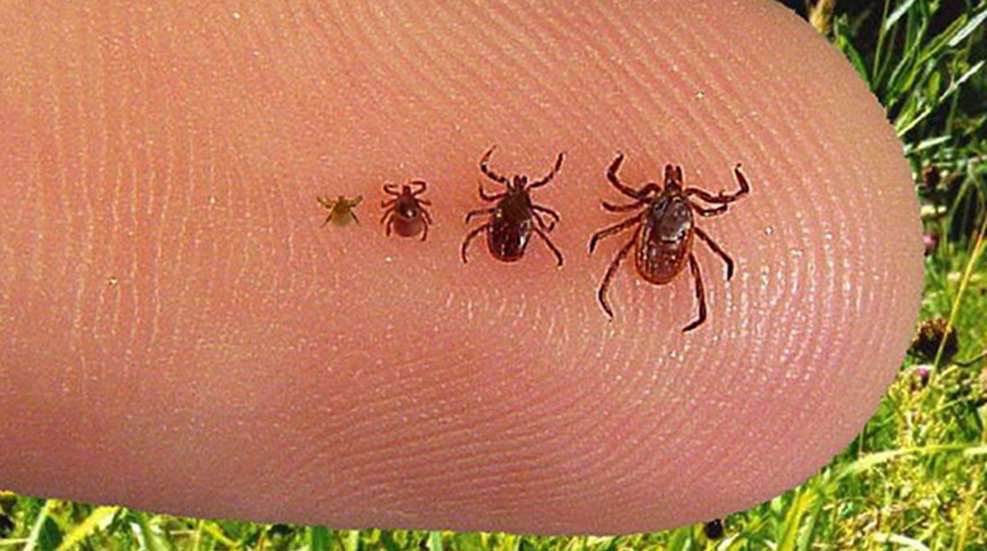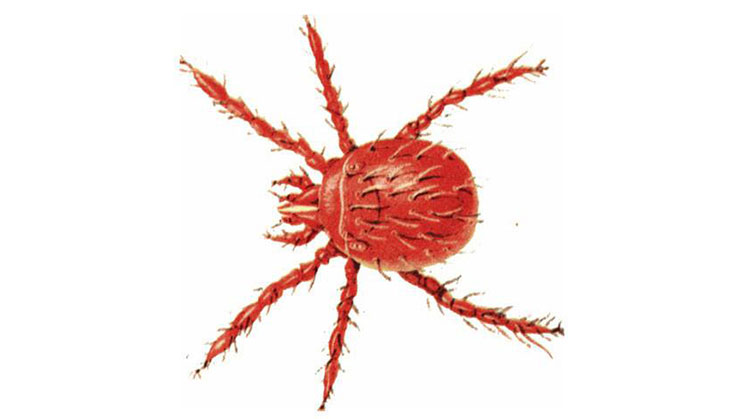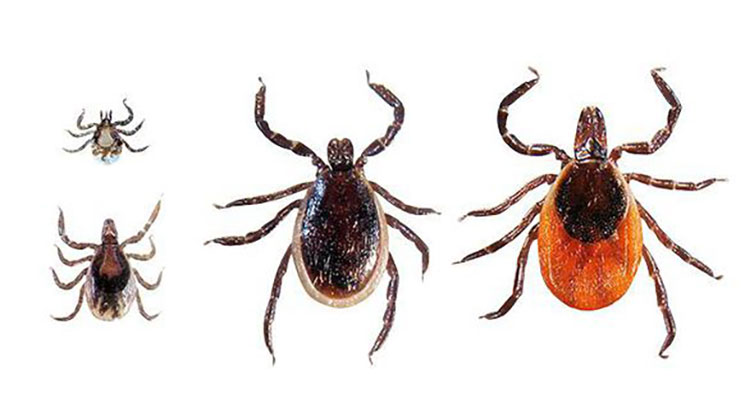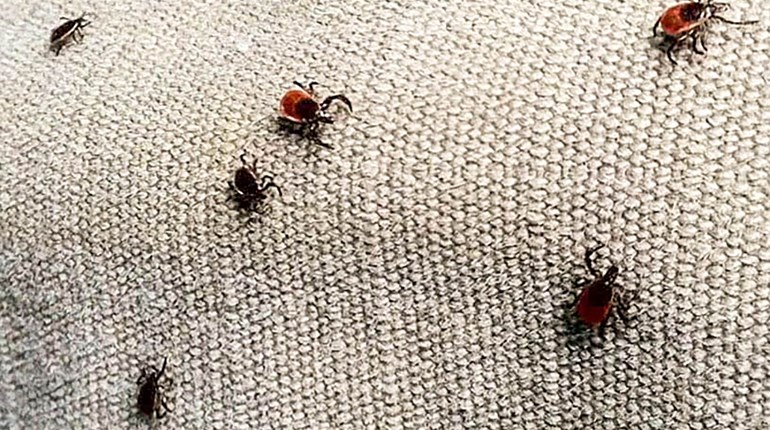
In 1933, Franklin D. Roosevelt said, “the only thing to fear is fear itself.” Well, excuse me, but I kindly disagree. I fear all sorts of things, like riding in a taxi with a deranged driver, flying in a bush plane during a bad storm, driving down a highway when the local bars are closing and many other sorts of seemingly mundane activities. Perhaps trust is a better word. I must trust the taxi driver, the pilot and the other person driving a vehicle. And I trust that when I walk into the woods and fields, I won’t have a nefarious encounter with a rattler or grizzly bear. But there are some things in the woods that I truly fear, because they can cause me both pain and illness. Worse, some of them are difficult (if not impossible) to see and can attack from anywhere. I speak of chiggers and ticks, two critters that can make a grown person cringe with horror and hysteria.

Chiggers
Let’s look at chiggers first, also called “red bugs.” They’re technically a mite, and are so small they almost look like a pencil dot. The only good thing about chiggers is that they reportedly don’t carry or cause disease. Other than that, there’s nothing positive about them. People often say that everything in life has a purpose. I believe chiggers’ purpose is to torment people. Mosquitoes, on the other hand, have a purpose, as much as I hate to admit it. Birds and bats eat them, and fish eat their larvae. On top of that, you can hear a pesky mosquito buzzing around you and even kill it with your hands if you’re quick enough. Unfortunately, mosquitoes can transmit nasty diseases.
Chiggers live in many environments where it’s hot and humid; from forests to golf courses, berry patches—anything that’s green and growing. Contrary to popular believe, chiggers don’t actually bite. In their larval stage, they open a small hole in your body, feed on the inner skin and drop off. By the time you feel the onset of itching, the varmint is having the last laugh in the leaves and grass. The worst thing you can do is to scratch, and I mean really scratch, so hard that you cause the site to bleed—and believe me, you’ll want to scratch very hard. Thankfully, there are remedies to relieve the itching. Ask your doctor or pharmacist what works best in your area. An old wives tale suggests painting the wound with fingernail polish to cut the oxygen supply off the little bad dude, but the joke is on the victim—the chigger has already vacated the premises. This treatment has been thoroughly dismissed by experts. As the affected area runs its course, you’ll observe a nasty sore which will form a small boil and then drain when it bursts. Obviously you won’t want to be wearing shorts at your neighbor’s barbecue or on the beach. I once had 30 or so chigger sores on my legs. I didn’t wear shorts for weeks.

Ticks
Ticks, on the other hand, indeed transmit diseases. Some will be debilitating, capable of causing a lifelong disability, or, in the worst case scenario, kill you. This is not intended to incite fear so you’re reluctant to enjoy the outdoors—it’s reality. Preventative measures are the answer. Unlike chiggers, which a quickie artists, and mosquitos, which is even speedier, ticks must hold on for awhile before they can do harm, typically at least 36 to 48 hours. According to the Center for Disease Control and Prevention (CDC), there are at least 16 kinds of tick-borne diseases in the United States. There are many culprits, including the black-legged tick, dog tick, deer tick, lone star tick, Rocky Mountain wood tick, western black-legged tick, Pacific Coast tick and others. It seems like every year new ticks and tick diseases are showing up, and don’t forget ticks abroad. One of my closest friends suffered a heart issue caused by a tick bite in South Africa.
Lyme disease is arguably the most prominent tick malady these days. First identified in 1975 in Lyme and Old Lyme, Connecticut, and transmitted by the dog and black-legged tick, an estimated 300,000 Americans are reportedly afflicted with Lyme disease annually. However, this figure may be low, as many cases are never reported. The good news is that in some areas, 1 percent or less of the bites from these ticks actually transmits the disease, but the figure is higher in other areas. There are treatments once a diagnosis is made, notably the Doxycycline antibiotic, among others. It’s commonly suggested that the first symptom is a “bull’s-eye” around the bite, but that’s not true in all cases. If symptoms occur, a visit to the doctor is mandatory. Symptoms vary, including flu-like symptoms such as fever, headaches, fatigue, chills, sore throat, body aches and others. The problem is, these symptoms are the same as with other illnesses. Worse, you may have been bitten by an infected tick and never know it until your primary care physician identifies it. Not long ago, many doctors were baffled by Lyme symptoms because the disease was so new, but nowadays a blood test will tell the story.
Another tick-borne illness making headlines is the lone star tick bite meat allergy. If you come down with this one, you’ll have a severe allergic reaction if you eat red meat. This was first discovered in the Southwest but has now spread to the East Coast.
Prevention comes in many forms. Most common is to spray your clothing and outdoor gear with a repellent containing 20 to 30 percent DEET or Permethrin. DEET reportedly repels ticks, while Permethrin kills them. The percentage of DEET in repellents are regulated in some states and Canada. Follow application instructions carefully. There are also vaccines, but from what I’ve read, they’re often ineffective and new research is constantly being conducted. These two repellents also work for chigger prevention.
When you come in the house from any outdoor activity, even barbecuing on your lawn in high-incident tick disease areas, it’s recommended that you put your clothes in the clothes dryer at a high setting, or if you’re washing them, use high heat—either will kill ticks. And don’t forget Fido or the family feline, both can carry ticks into your home. Check with your veterinarian for proper treatment in your region, since they may vary.
Tick-transmitted diseases have varying symptoms. Never take a tick bite lightly. If in doubt, see your doctor immediately. But most of all, don’t shun the outdoors, ticks are here to stay. Common sense and preventative measures will help you avoid them and their nasty gifts to mankind.
For additional information on ticks, check out the following articles:
• A Simple, Safe Way to Remove Ticks
• Tips for Dealing With Ticks





































